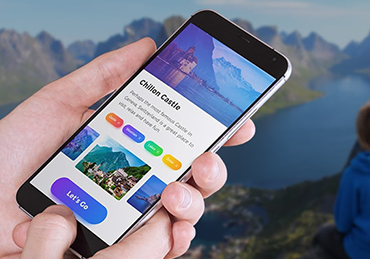Tips for Translating English to Different Languages
If you want to say good morning in different languages or translate any other common greeting, we have a few tips to get you started!
Learning a new language isn’t always easy (trust us, we’ve been there!). But with a few tools in your belt, you’ll spend less time spinning your wheels and more time communicating effectively.
Learn Common Words and Phrases First
Many languages have common words and phrases that are used over and over.
In every language, you’ll find locals saying hello, good morning, goodbye, thank you, how are you, and a wide variety of other formalities.
If you learn these formalities and common words and phrases first, you’ll have a leg up on learning the rest of the language.
You can also find out which words and phrases are most commonly used within a specific language; focusing on these words and phrases will help you understand a huge chunk of the vocabulary. Understanding the most commonly used words may help you gain the confidence you need to keep going.
Download a Language Translation App
It’s not easy Google Translating every word and phrase as your learning a new language — or if you’re trying to translate one language to another.
Language translation apps have come a long way over the years. You can look up individual words with a few keystrokes, or you can use voice-input and output features or voice-to-text features to translate words, sentences, and phrases in real-time.
Vocre’s language translation app can translate voice or text online or off. You don’t even need a wifi or cell connection to use the app once you’ve downloaded the dictionary. Use it to learn the translation of common words and phrases.
Immerse Yourself in the Culture
Most fluent speakers will tell you that the best way to learn any language is to immerse yourself in the culture and the language itself.
Take a language class (either online or in-person). Travel to an area of the world where the language is spoken.
Spanish isn’t only spoken in Spain and Latin America! It’s spoken in New York City, Los Angeles, and many other cities across North America and Europe. Similarly, French is spoken not only in France but in many areas of Canada.
Once you know some basic phrases, visit a coffee shop or cafe in an area where the language is spoken (or watch movies or TV shows in a foreign language) to force your brain to start listening in this language.
If you need some inspiration, check out our picks for Spanish Language Movies on Netflix!
Keep It Simple
One of the hardest parts of translating a language is incorporating inflections, idioms, humor, and other hard-to-translate figures of speech.
When translating, try to keep things as simple as possible. You won’t understand the nuance in every word or phrase right away. If you’re practicing a language with a partner, ask your partner to keep things simple to help you learn the language in the easiest way possible.
Ask your partner about commonly used phrases or terms that are often used in the language in question. Similarly, you may not want to speak with your language partner in your native language using complex words or phrases that are difficult to translate.
Yet, explaining phrases such as, “I’ve been there,” or, “I get you,” will help your partner learn how to say some commonly used phrases.
Common Greeting Translations
One of the easiest ways to learn a new language is to start at the beginning — as Julie Andrews would have said in The Sound of Music.
Greetings are a great place to start because they’re simple and offer insight into how a culture thinks and feels.
In English, we say, Hello, good morning, nice to meet you, and goodbye. In Italian, people say, Ciao, Buon giorno, piacere, and… ciao again! In many languages, the words for hello and goodbye are the same — which says a lot about the culture in question.
In many other cultures, it’s also polite to say a few words or phrases in the other person’s language before explaining that the rest of your understanding of the language is limited.
Most Common Words in a Language
Many languages have a list of their most commonly used words. These words are often prepositions, articles, and pronouns. Once you know these words, you’ll find it much easier to translate larger chunks of text.
Some of the most common words in English include:
- Are
- Be
- Been
- Can
- Could
- Do
- Go
- Had
- Has
- Have
- Is
- Like
- Look
- Make
- Said
- See
- Use
- Was
- Were
- Will
- Would
Some of the most common nouns in English include:
- Child
- Day
- Eye
- Hand
- Life
- Man
- Part
- Person
- Place
- Thing
- Time
- Way
- Woman
- Work
- World
- Year
You can really understand what English speakers value just by scanning a list of the most commonly used words in English!
Good Morning in Different Languages
Ready to start saying good morning in different languages? We’ve compiled a guide on how to say good morning in some of the most commonly used languages on the Vocre app!
Learn how to say good morning in Spanish, Chinese, Italian, Arabic, Persian, and other commonly used languages. We also offer language translation for lesser-used languages, too!
Good Morning in Spanish
While Spanish language translation isn’t always easy, saying good morning in Spanish is relatively easy. If you can say good morning in English, you can probably say it in Spanish, too!
The word for good in Spanish is buenos and the word for morning is mañana — but here’s the kicker: you don’t say, “Good morning,” in Spanish but rather, “good days.” The word for day in Spanish is dia, and the plural form of dia is dias.
To say good morning in Spanish, you’d say, “Buenos dias,” which is pronounced, “bwen-ohs dee-yas.”
Similarly, you could also say hello, which is, “Hola.” In some Spanish-speaking countries, the phrase good morning or buenos dias is shortened to buen dia but pronounced altogether such as, “Buendia.”
Good Morning in Telugu
Telugu is most commonly spoken in the Indian states of Andhra Pradesh and Telangana. It is the official language of these states as well as West Bengal and parts of Puducherry. Telugu is one of the classical languages of India.
82 million people speak Telugu, and it’s the fourth most spoken language in India.
A Dravidian language (one of the primary language families), and it’s the most widely spoken Dravidian language.
In the U.S., half a million people speak Telugu, and it’s the fastest-growing language in the country.
If you want to say good morning in Telugu, the literal translations are, “Śubhōdayaṁ,” or, “śuprabhataṁ.” Yet, most people simply say, “Namaskaram.
Good Morning in Italian
Italian is another language descended from vulgar Latin. It is the official language of Italy, Switzerland, San Marino, and Vatican City.
Since there are large Italian diasporas across the world, it is also widely spoken in immigrant countries, such as the U.S., Australia, and Argentina. More than 1.5 million people speak Italian in Argentina, nearly one million people speak this language in the U.S. and over 300,000 speak it in Australia.
It’s the second-most widely spoken language in the E.U.
If you wanted to say good morning in Italian, you could say, “Buon giorno.” The extra good news is that since the literal translation of buon giorno is good day, you can say buon giorno in the morning or early afternoon!
Good Morning in Chinese
Chinese itself isn’t a language!
But Mandarin and Cantonese are. These are the two languages most people are referring to when they talk about the Chinese language — though there are many other languages classified as Chinese, too.
Chinese is most widely spoken in China as well as in the countries that were once occupied or a part of China. Mandarin is widely spoken in northern and southwestern China. It’s also the official language of the People’s Republic of China, Singapore, and Taiwan.
If you want to say good morning in Chinese (Mandarin), you’d say, “Zǎoshang hǎo,” which is the translation and the way people greet each other in the morning in Mandarin.
Good Morning in Persian
Persian is spoken mostly in the Middle East and Central Asia. It’s also called Farsi in some parts of the word; in fact, Persian is the term English-speaking people use for the language, and Farsi is the term used by native speakers.
62 million people are native speakers across the globe. It’s the 20th most widely spoken language, and 50 million people speak Farsi as a second language.
Over 300,000 people in the U.S. speak Farsi.
If you want to say good morning in Farsi, you’d say, “Sobh bekheyr,” or, “sobh bekheir.”
Want some English-to-Persian tips and tricks? Check out our article on how to say other important phrases in Farsi.
Good Morning in Arabic
Arabic is another language commonly spoken in the Middle East. It is the official or co-official language in more than 25 countries, including:
Saudi Arabia, Chad, Algeria, Comoros, Eritrea, Djibouti, Egypt, Palestine, Lebanon, Iraq, Jordan, Lebanon, Kuwait, Mauritania, Morocco, Oman, Qatar, Somalia, Sudan, Syria, Tanzania, Bahrain, Tunisia… the list goes on and on!
Even though the two languages are both spoken in the Middle East, Arabic differs greatly from Farsi. In fact, Arabic and Farsi come from two completely different language families!
If you want to say good morning in Arabic, you would say, “Sabah el kheir.” It’s used both formally and informally (as in English!).
Good Morning in Kurdish
The Kurdish language is spoken in Armenia, Azerbaijan, Iran, Iraq, and Syria.
There’s not just one Kurdish language either! There are three Kurdish languages, including Northern, Central, and Southern Kurdish.
It’s estimated that 20.2 million people in the world speak Kurdish all over the world. Turkey is the country most populated by native Kurdish speakers and is home to 15 million speakers. Kurdistan, where Kurdish is predominantly spoken includes the areas of northern Iraq, southeastern Turkey, northern Syria, and northwestern Iran.
Looking for a Kurdish translation for the phrase good morning? “Beyanî baş,” is how you say good morning in Kurdish Sorani, the predominant Kurdish language spoken in Iraqi Kurdistan and the Iranian Kurdistan Province.
Good Morning in Malay
290,000,000 people in the world speak Malay! It’s most widely spoken in Malaysia, Indonesia, Brunei, Singapore, Philippines, Myanmar, Thailand, Coco Island, Christmas Island, Sri Lanka, Suriname, and Timor.
25,000 people in the U.S. also speak Malay, too. Tens of thousands of people who speak Malay as a first language live across Europe and in other Malaysian diasporas.
If you want to say good morning in Malay, you’d say, “selamat pagi.” Want to know what saying good morning in Malay sounds like? Use our Malay to English translation in our Vocre app!
Good Morning in Nepali
Nepali is the official language of Nepal and one of the languages of India. It is an Indo-Aryan language of the sub-branch of Eastern Pahari. 25% of the citizens of Bhutan also speak Nepali.
Nepali is often confused with Hindi, as the two languages are very similar, and both are spoken in Nepal and India. They both follow the Devanagari script.
The literal translation of good morning in Nepali is, “Śubha – prabhāta. Subha means good and prabhat means morning. Another word for morning is bihani or bihana.
There are just under 200,000 Nepalese in the U.S. who speak Nepali, too. Other diasporas of Nepalese people include India (600,000), Myanmar (400,000), Saudi Arabia (215,000), Malaysia (125,000), and South Korea (80,000).









